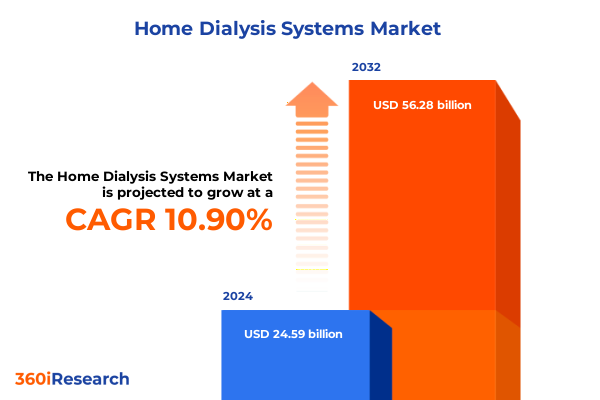The Home Dialysis Systems Market size was estimated at USD 24.59 billion in 2024 and expected to reach USD 27.25 billion in 2025, at a CAGR of 10.90% to reach USD 56.28 billion by 2032.

Introducing the Expanding Landscape of Home Dialysis Systems and the Imperative for Patient-Centric, Technology-Driven Treatment Solutions
The home dialysis arena has become one of the most dynamic segments within chronic kidney care, driven by technological advancements and a growing patient preference for treatment flexibility. As the burden of end stage renal disease continues to rise globally, healthcare systems are increasingly encouraging therapeutic models that shift care from centralized facilities into the home environment. This transformation not only addresses capacity constraints in clinical settings but also aligns with evolving patient expectations, as individuals seek personalized, comfortable, and cost-effective treatment alternatives.
Amid this shift, industry stakeholders are challenged to innovate rapidly across both device and service domains. Advances in miniaturized blood pumps, user-friendly interfaces, and remote monitoring platforms are converging to deliver more intuitive and reliable dialysis experiences. At the same time, regulatory bodies and payers are establishing frameworks that incentivize home therapies, heightening the importance of comprehensive care protocols and robust patient support infrastructures. As a result, manufacturers, providers, and payers alike must adopt an integrated approach to navigate these trends, ensuring that technological progress translates into tangible clinical and economic benefits.
Exploring the Transformative Shifts Reshaping Home Dialysis Treatment Models Through Innovation, Care Protocols, and Regulatory Evolution
Recent years have witnessed seismic shifts in the home dialysis ecosystem, as emerging technologies redefine what is possible in patient care. Telehealth platforms now enable real-time data transmission and remote clinical oversight, allowing care teams to intervene proactively and adjust treatment parameters without requiring in-person visits. This digital evolution has been complemented by advances in artificial intelligence and predictive analytics, which together improve treatment adherence, optimize fluid removal rates, and identify early signs of complications.
Concurrent changes in care protocols and reimbursement models are also reshaping stakeholder incentives. Payers are increasingly linking reimbursement to patient-reported outcomes and quality measures, encouraging holistic approaches that encompass nutrition, mental health, and caregiver engagement. Moreover, regulatory reforms have streamlined approvals for innovative home dialysis platforms, accelerating their commercialization and adoption. Taken together, these developments are powering a new generation of patient-centric care models that prioritize safety, efficacy, and quality of life.
Evaluating the Cumulative Impact of 2025 United States Tariffs on Supply Chain Resilience, Cost Structures, and Affordability in Home Dialysis
The implementation of new United States tariff regulations in early 2025 has introduced a series of challenges across the home dialysis value chain. Import levies on key components, including electronic boards, pumps, and specialized plastic resins, have led to increased costs for both machines and consumables. As manufacturers absorb these additional expenses, some costs are being passed through to end users, raising concerns about treatment affordability and potential disruptions in patient access.
In response, organizations have adopted multifaceted mitigation strategies to safeguard supply chain continuity and cost stability. Vertical integration initiatives have gained traction, with certain device makers exploring in-country production of filters and dialysate concentrates. Others have renegotiated long-term contracts with suppliers to secure fixed pricing and prioritized inventory management to smooth out fluctuations. While these efforts have softened the immediate financial impact, sustained attention will be required to balance quality standards with cost containment, particularly as tariff policies continue to evolve.
Unveiling Critical Segmentation Insights Spanning Dialysis Modalities, Device Categories, Distribution Pathways, and End User Dynamics
A deeper examination of market segmentation reveals distinct strategic priorities for industry participants. When analyzing modality, the landscape splits between home hemodialysis and peritoneal dialysis, each presenting unique clinical and operational considerations. Within home hemodialysis, the spectrum ranges from conventional regimens to nocturnal offerings and abbreviated daily treatments, while peritoneal dialysis encompasses both automated systems and continuous ambulatory formats. Device type segmentation further highlights the need to align development roadmaps across accessories, core machines, and consumables, the latter of which includes both dialysate concentrates and specialized filters that underpin daily therapy safety and efficacy.
Distribution channel analysis underscores divergent approaches to customer engagement, as manufacturers navigate both online platforms and traditional retail networks to optimize reach and service delivery. Equally critical is the distinction between home healthcare agency–facilitated programs and self-administration models, which dictate training requirements, support infrastructure, and adherence strategies. By comprehensively understanding these segments, stakeholders can fine-tune product portfolios, align marketing investments, and tailor care models to meet diverse patient and provider needs.
This comprehensive research report categorizes the Home Dialysis Systems market into clearly defined segments, providing a detailed analysis of emerging trends and precise revenue forecasts to support strategic decision-making.
- Modality
- Device Type
- End User
- Distribution Channel
Charting Key Regional Dynamics Influencing Home Dialysis Adoption Across the Americas, Europe Middle East Africa, and the Asia Pacific
Regional dynamics exert a profound influence on home dialysis adoption and market development. In the Americas, robust reimbursement frameworks in the United States and Canada have fueled rapid uptake of home therapies, bolstered by established chronic care networks and patient advocacy initiatives. Meanwhile, Latin American countries are emerging as growth opportunities, where cost sensitivity and infrastructure variability demand adaptable, lower-cost solutions and strategic partnerships with local distributors.
Across Europe, the Middle East, and Africa, the pace of home dialysis integration varies substantially. Western European nations benefit from harmonized regulatory standards and integrated healthcare systems, whereas market penetration remains nascent in parts of the Middle East and sub-Saharan Africa, where logistical constraints and resource limitations persist. In the Asia-Pacific region, rapid urbanization, rising incidences of diabetes, and targeted government incentives are driving demand in China, India, and Australia. However, complex regulatory consortia and uneven clinical training frameworks necessitate localized product adaptations and expanded educational programs.
This comprehensive research report examines key regions that drive the evolution of the Home Dialysis Systems market, offering deep insights into regional trends, growth factors, and industry developments that are influencing market performance.
- Americas
- Europe, Middle East & Africa
- Asia-Pacific
Examining Strategic Competitive Dynamics Among Leading Manufacturers and Their Role in Shaping the Home Dialysis Market Ecosystem
Competition within the home dialysis market is intensifying, as established medical technology leaders and nimble innovators vie for market share. Major global players have accelerated product innovation cycles, launching advanced hemodialysis platforms equipped with integrated telemonitoring and user-friendly interfaces. In parallel, strategic alliances and joint ventures have emerged, aimed at co-developing next-generation peritoneal dialysis solutions and bolstering regional distribution capabilities.
Furthermore, a wave of mergers and acquisitions has reshaped the competitive landscape, enabling companies to expand their product portfolios and achieve synergies in manufacturing and R&D. Leading manufacturers are also investing heavily in digital health ecosystems, partnering with software developers and data analytics firms to deliver comprehensive remote patient management suites. As these competitive dynamics unfold, differentiation through clinical evidence, service excellence, and seamless user experiences will be critical for securing long-term leadership.
This comprehensive research report delivers an in-depth overview of the principal market players in the Home Dialysis Systems market, evaluating their market share, strategic initiatives, and competitive positioning to illuminate the factors shaping the competitive landscape.
- Allmed Medical Care Holdings Limited
- AWAK Technologies Pte. Ltd.
- B. Braun Avitum AG
- Bain Medical Equipment Co., Ltd.
- Baxter International Inc.
- DaVita Inc.
- Fresenius Medical Care AG & Co. KGaA
- Infomed SA
- Jiangsu Jihua Medical Instruments Co., Ltd.
- JMS Co., Ltd.
- Kawasaki Laboratories, Inc.
- Medica SpA
- Medical Components, Inc.
- Medtronic plc
- Nikkiso Co., Ltd.
- Nipro Corporation
- Outset Medical, Inc.
- Quanta Dialysis Technologies Ltd.
- Rockwell Medical, Inc.
- SWS Hemodialysis Care
- Toray Medical Co., Ltd.
- Weigao Group
Delivering Actionable Recommendations for Industry Leaders to Navigate Market Disruptions, Regulatory Complexities, and Evolving Patient Expectations
To thrive amid evolving market pressures, industry leaders must adopt a multifaceted strategy. First, they should prioritize investment in digital health platforms and remote monitoring tools, ensuring that care teams can deliver proactive interventions and maintain high levels of treatment adherence. Simultaneously, companies should diversify their supply chains by fostering partnerships with regional suppliers and exploring local production for key consumables to mitigate tariff-related risks and logistical bottlenecks.
Additionally, forging deep collaborations with payers and policy makers will be essential for securing favorable reimbursement models that reward holistic patient outcomes rather than procedure volume alone. Equally important is the development of comprehensive training programs tailored to both home healthcare agencies and self-administration cohorts, empowering patients and caregivers with the knowledge and confidence required for effective home therapy management. Together, these actions will position organizations to capitalize on growth opportunities while driving superior clinical and economic outcomes.
Detailing the Comprehensive Multi-Source Research Methodology Underpinning Rigorous and Unbiased Analysis of Home Dialysis Systems
Our research methodology integrates rigorous primary and secondary approaches to ensure robust, unbiased insights. The primary phase included in-depth interviews with nephrologists, dialysis nurses, homecare program managers, and patient advocates, supplemented by workshops with supply chain and reimbursement experts. Concurrently, we conducted a comprehensive review of publicly available regulatory documents, clinical trial registries, and real-world evidence repositories to validate trends and performance benchmarks.
To reinforce validity, we employed triangulation, cross-verifying qualitative insights with quantitative data obtained from industry databases and financial reports. An expert panel comprising clinicians, health economists, and device engineers provided iterative feedback on preliminary findings, ensuring objectivity and practical relevance. Throughout the research process, strict quality controls were maintained, including protocol adherence checks and peer reviews, to deliver a thoroughly vetted analysis of the home dialysis systems landscape.
This section provides a structured overview of the report, outlining key chapters and topics covered for easy reference in our Home Dialysis Systems market comprehensive research report.
- Preface
- Research Methodology
- Executive Summary
- Market Overview
- Market Insights
- Cumulative Impact of United States Tariffs 2025
- Cumulative Impact of Artificial Intelligence 2025
- Home Dialysis Systems Market, by Modality
- Home Dialysis Systems Market, by Device Type
- Home Dialysis Systems Market, by End User
- Home Dialysis Systems Market, by Distribution Channel
- Home Dialysis Systems Market, by Region
- Home Dialysis Systems Market, by Group
- Home Dialysis Systems Market, by Country
- Competitive Landscape
- List of Figures [Total: 28]
- List of Tables [Total: 555 ]
Concluding Perspectives on Home Dialysis Market Evolution and Strategic Imperatives for Sustained Innovation and Growth
Home dialysis systems are poised at a critical inflection point, where converging technological, regulatory, and patient-driven forces are redefining care paradigms. The rise of telehealth and AI-driven decision support is enhancing safety, personalization, and operational efficiency, while an increasingly segmented market necessitates bespoke approaches to modality, device type, and distribution. Moreover, shifting tariff policies underscore the need for resilient supply chains and agile cost management.
Looking forward, stakeholders that excel at integrating advanced technologies with robust patient support models will emerge as market leaders. Success will hinge on a deep understanding of regional nuances, targeted product development aligned with end user needs, and a willingness to forge cross-sector collaborations. By embracing these imperatives, organizations can navigate uncertainties, elevate patient experiences, and secure sustainable growth in the home dialysis domain.
Empowering Decision Makers with Exclusive Market Intelligence and Insights — Connect with Associate Director Ketan Rohom Today
To secure your competitive advantage in the rapidly evolving home dialysis landscape, reach out to Ketan Rohom, Associate Director of Sales & Marketing, to access the full market research report designed to empower your strategic planning and business growth.

- How big is the Home Dialysis Systems Market?
- What is the Home Dialysis Systems Market growth?
- When do I get the report?
- In what format does this report get delivered to me?
- How long has 360iResearch been around?
- What if I have a question about your reports?
- Can I share this report with my team?
- Can I use your research in my presentation?




